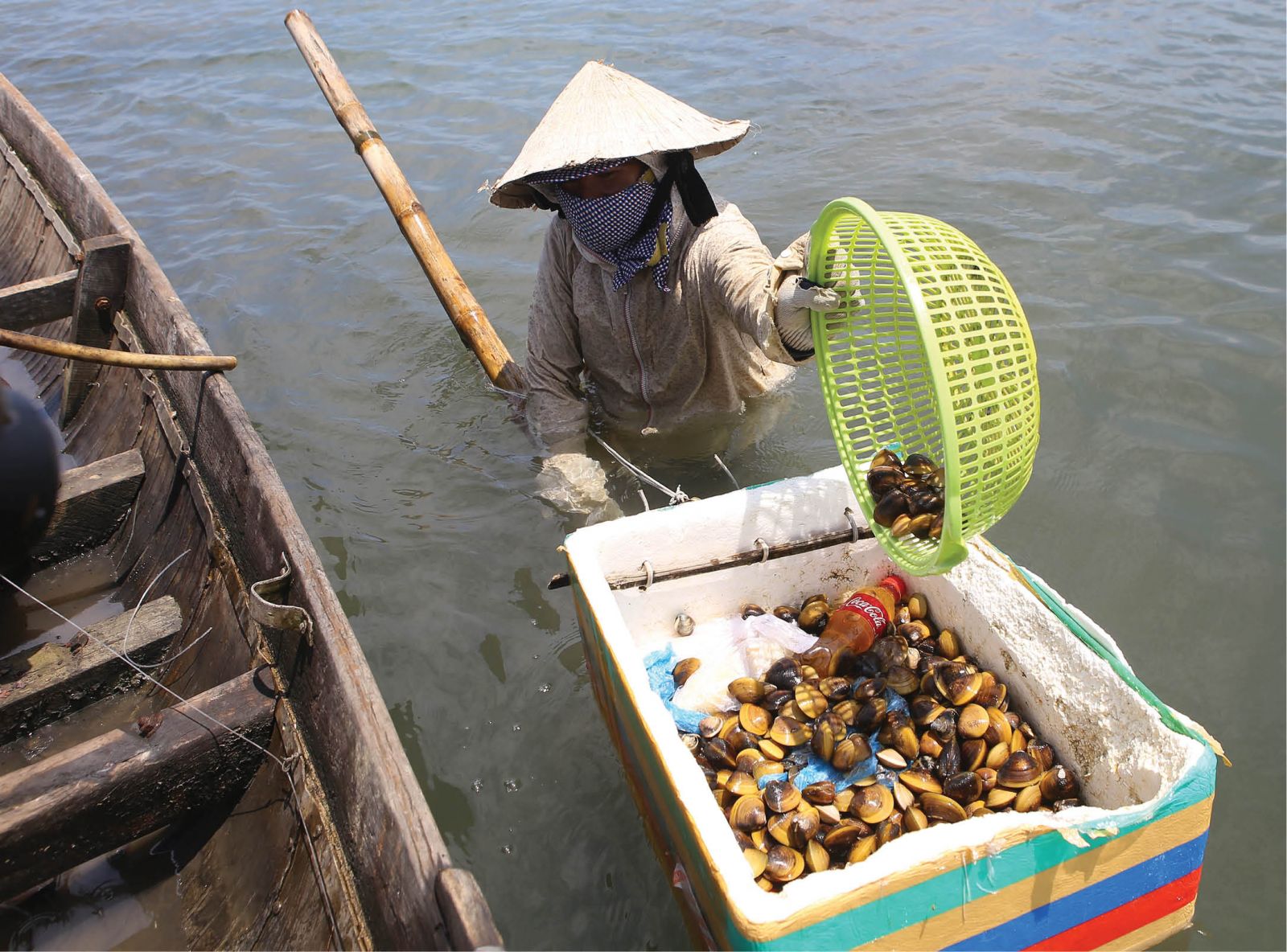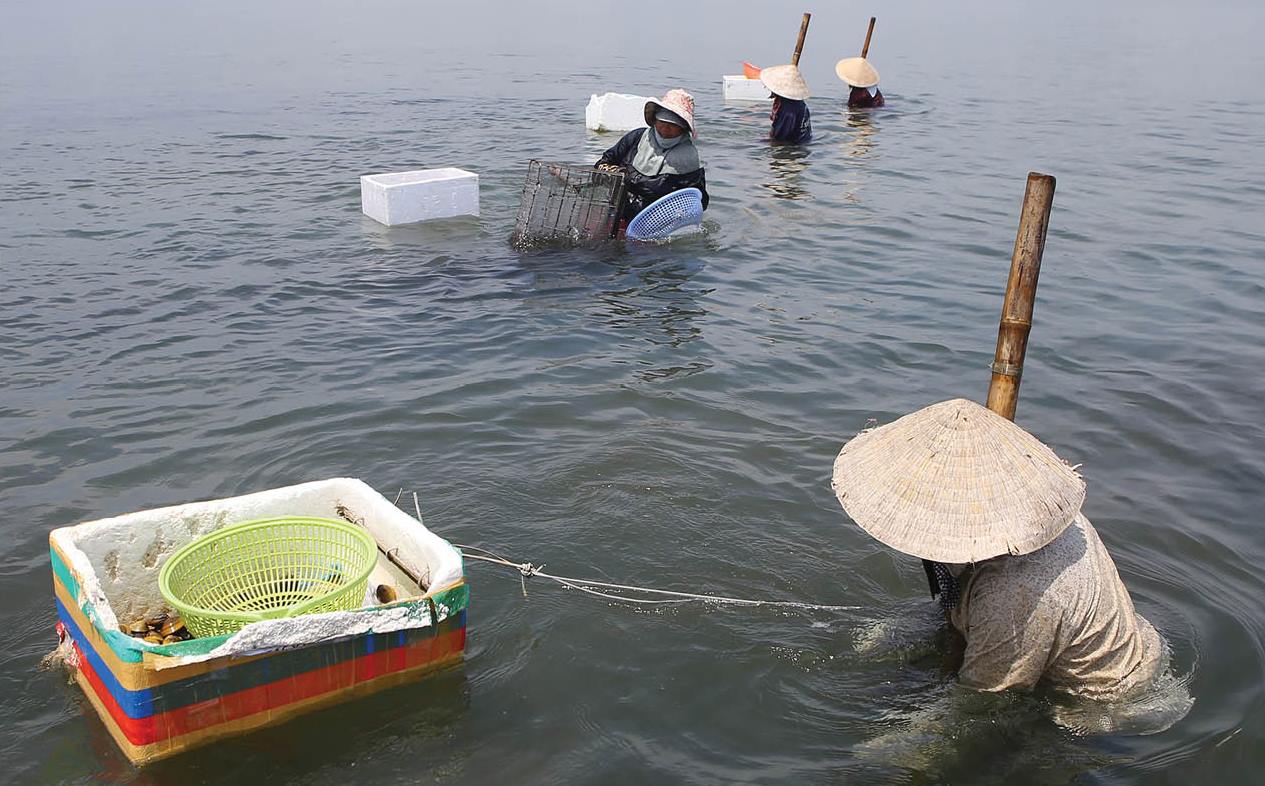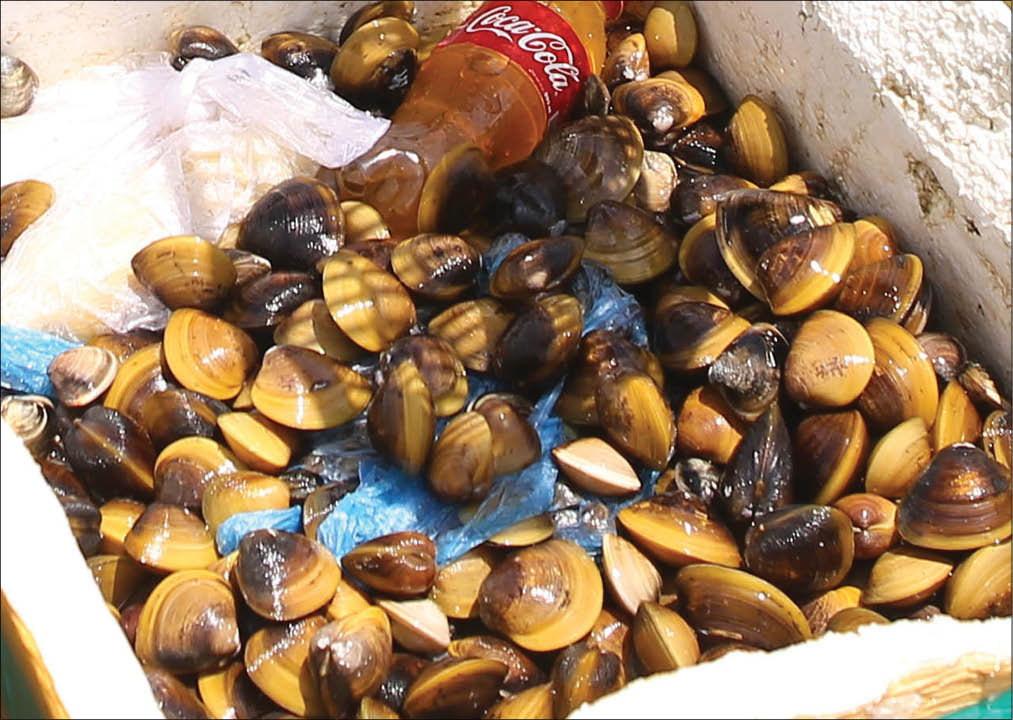
It is hard work, but brings back pretty good income
Working for fun, but earning a lot
Huong Phong (Huong Tra dist.) is an agricultural area, well known for its buffalo herd. Every family raises buffalo; everyone tends buffalo. It is also the “capital city” of inhabitants by the sea with the career of clam collecting that brings back up to millions of dongs every day.
We dropped by Mr. Dang Duy Phung's house (Thuan Hoa B Village, Huong Phong Commune) when clams had been in season for two months. It was hard to meet him in person at this time of the year because he and his wife were busy collecting clams for a living.
Clams living in brackish water in the estuary taste better than those in muddy Tam Giang Lagoon. Fortunately, Mr. Phung was at home that day, waiting for the merchant who would come to buy clams.
Mr. Phung spared 2 hours to talk with me. “After that, I will have to work. At this time of the year, a day off means losing lots of money.” “Villagers in Thuan Hoa B call this the career of ‘eating forward, working backward’,” said Mr. Phung.
“Man” means “work.” Working for fun, but earning a lot. When collecting clams, they have to walk backward, holding an A-shaped tool with a net. When the tool being pulled, dirt and mud are removed while clams stay.
Clams are in season from February to August every year. At this time, when the current is pushed ashore, carrying clams hidden under the mud, the clam season begins.

Diligence is the typical beauty of women in Huong Phong
There are more than 120 families in Thuan Hoa B specializing in collecting clams. In early February, they begin to prepare tools for the main clam season.
In Thuan An Estuary, there are 3 types of clam: tria lip, tria u and tria mo of which tria lip is the most expensive, about VND140.000 per kilogram. Tria lip are as small as little fingers, but they are the merchant’s favorite because they will serve as breeding clams.
Clams must be alive and in full shape without scratches or breaks. They are sold to be raised in the lagoon. When they are as big as small bowls, they are consumed in restaurants. Tria u and tria mo are cheaper, but they are also sold out easily right at the lagoon.
A clam collector earns VND500.000-700.000 per day. In an agricultural area such as Huong Phong, it is considered good income. Men also help transport clams when they are not too busy with farming.
The peaceful village at the estuary becomes bustling with engine noises when clams are brought to shore. The clam season ends when white water currents rush in from rivers, signaling the season of storms.

Tria mo, Huong Phong’s speciality
Mothers carry clams; their children “carry” knowledge
For about 10 years now, collecting clams has been the work done by women because men either go to the sea or are busy with farming. The image of women wearing conical hats in the scorching sun at the lagoon has become familiar in this estuary area.
From there, baskets of fresh clams follow women uplands. Clam collecting becomes livelihood for families who live mainly on agriculture.
In other areas at Tam Giang Lagoon, people often collect clams by groping for them or diving into the sea. Collecting clams in this way at Thuan Hoa B is more effective though it is done completely manually.
| Talking to Mr. Dang Duy Phung over a bowl of fresh tria mo, fragrant with lemongrass, we could feel the hardship of the career of “working backward” as well as the favor that was granted by Nature for the area at the end of the Perfume River. Clams help diversify the seafood menu at tourist sites such as Con Te, Ru Cha. |
Two hours passed. Mr. Phung took me to the river in a motorboat. Hardly had I turned on the camera when the two women jumped into the river, bringing their A-shaped tools.
Clam collectors brought with them Styrofoam boxes to contain clams. They pushed their tools into the mud, about 10cm deep, then began to walk backward. From time to time, they turned their heads up to breathe.
“It is necessary to choose shallow water bodies and to walk backward toward the shore. It is even harder for women because they have to dip their bodies in cold water all day. But we are now used to it,” confided Mrs. Nguyen Thi Thuy.
From down the river, Mrs. Nguyen Thi Nguyet, a clam collector with 10 years of experience, was smiling so happily because it was a successful day for her. “This work is mainly for women. We are not as strong as men and some women cannot stand it. But all the tiredness is gone when we think of the clams sold out tomorrow and that our children can go to school,” confided Mrs. Nguyet.
“It’s simple, isn’t it? But we need experience about water currents too. When clams follow currents to the shore, we must know when the tide rises and falls. If not, we may go home empty-handed,” continued Mrs. Nguyen Thi Thuy.
Mrs. Thuy told me while taking a break that collecting clams was hard work but the collectors were always happy with smiles on their faces. They knew over there, on-shore, their small children were going to school. Talking about their children’s studies, it was as if their eyes were brighter with happiness.
Mrs. Thuy had 3 children. Two of them were university students while the other had graduated. Tran Thi Xiu’s two children were cherishing their dream at the village school.
Story and photos: Ha Nguyen